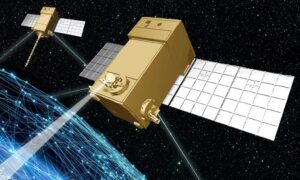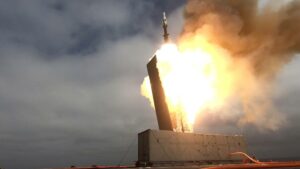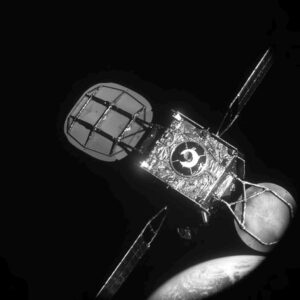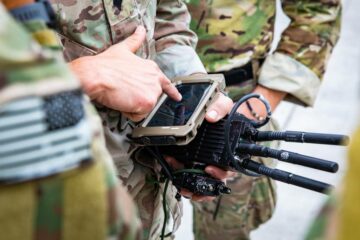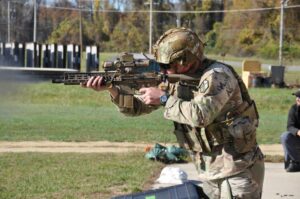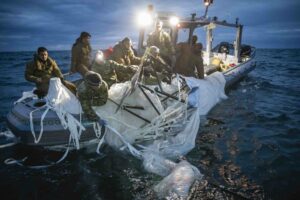
ST. LOUIS —The National Geospatial-Intelligence Agency will demonstrate the ability to process and disseminate data in hard-to-reach locations at several military exercises this summer.
The agency, the intelligence community’s lead organization for analyzing satellite imagery and turning it into usable data, is developing four Joint Regional Edge Nodes, or JRENs, that will be based in various locations around the world. The idea is to stage the processors closer to users, allowing them to receive and distribute large swaths of data on faster timelines.
The first node, which NGA expects to deliver in fiscal 2024, will be located in U.S. Indo-Pacific Command.
Fred Ingham, the agency’s deputy chief information officer, said NGA will showcase JREN as part of multiple military exercises in July, though he didn’t specify which ones.
“Getting this capability out forward supports our analysts that are out in the field,” Ingham said May 24 at the GEOINT Conference in St. Louis, Missouri. “It will also support applications so that when they are disconnected, they still have all the applications they need on this Joint Regional Edge Node and be able to operate as if they were connected back to our data centers.”
Last December, NGA Director Vice Admiral Frank Whitworth described JREN as a way to handle what he described as a “deluge” of data and to address the challenge of sharing that information in remote locations.
The agency relies on what’s called the National System for Geospatial Intelligence, or NSG, to distribute nearly a petabyte of data around the globe each day. Since 2018, it has relied on the Odyssey GEOINT Edge Node to process sensor data and help operators on the ground use that data to make real-time decisions.
Odyssey has been in high demand from various combatant command, and JREN provides a chance to increase that capacity while also providing a more resilient capability.
According to E.P. Mathew, deputy chief information officer at the Defense Intelligence Agency, placing more processing nodes across the globe supports the National Defense Strategy, which calls for decentralizing systems and approaches. Systems like JREN, designed for degraded locations where access to the cloud may not be available, help the intelligence community support international partners, combatant commands and defense attaches, he said during the same May 23 panel.
“How do I provide information to them in either a cloud disconnected or degraded environment? In that scenario, cloud computing does not work or is not ideal,” Mathew said. “I have to think in terms of resiliency, redundancy, with the intent of passing information to the warfighter or the policymaker in the short time that is available.”
Courtney Albon on C4ISRNETi kosmose- ja areneva tehnoloogia reporter. Ta on tegelenud USA sõjaväega alates 2012. aastast, keskendudes õhujõududele ja kosmosejõududele. Ta on andnud ülevaate kaitseministeeriumi kõige olulisematest omandamis-, eelarve- ja poliitikaprobleemidest.
- SEO-põhise sisu ja PR-levi. Võimenduge juba täna.
- PlatoAiStream. Web3 andmete luure. Täiustatud teadmised. Juurdepääs siia.
- Tuleviku rahapaja Adryenn Ashley. Juurdepääs siia.
- Ostke ja müüge IPO-eelsete ettevõtete aktsiaid koos PREIPO®-ga. Juurdepääs siia.
- Allikas: https://www.defensenews.com/battlefield-tech/2023/05/24/national-geospatial-intelligence-agency-to-demo-data-processing-node/
- :on
- :on
- :mitte
- : kus
- ][lk
- 10
- 2012
- 2018
- 2024
- 23
- 24
- 70
- a
- võime
- Võimalik
- juurdepääs
- omandamine
- üle
- aadress
- agentuur
- AIR
- Lennuvägi
- Materjal: BPA ja flataatide vaba plastik
- Lubades
- Ka
- Analüütikud
- analüüsides
- ja
- rakendused
- lähenemisviisid
- OLEME
- ümber
- AS
- At
- saadaval
- tagasi
- põhineb
- BE
- olnud
- eelarve
- kutsutud
- Kutsub
- Võimsus
- Centers
- väljakutse
- väljakutseid
- võimalus
- juht
- lähemale
- Cloud
- cloud computing
- kogukond
- arvutustehnika
- Konverents
- seotud
- kaetud
- andmed
- andmekeskuste
- andmetöötlus
- päev
- Detsember
- otsused
- kaitse
- tarnima
- Nõudlus
- Demo
- näitama
- asetäitja
- kirjeldatud
- kavandatud
- arenev
- Juhataja
- lahti
- levitada
- do
- ei
- ajal
- e
- iga
- serv
- kumbki
- smirgel
- Arenev tehnoloogia
- keskkond
- ootab
- kiiremini
- väli
- esimene
- Maksualane
- Keskenduma
- eest
- Sundida
- edasi
- Alates
- maakera
- Maa
- käepide
- Olema
- he
- aitama
- Suur
- HTTPS
- i
- idee
- ideaalne
- if
- pildid
- in
- Suurendama
- info
- Intelligentsus
- tahtlus
- rahvusvaheliselt
- sisse
- IT
- ühine
- jpg
- Juuli
- suur
- viima
- nagu
- asub
- kohad
- Louis
- tegema
- mai..
- Sõjaline
- rohkem
- kõige
- mitmekordne
- riiklik
- peaaegu
- Vajadus
- sõlme
- sõlmed
- of
- Ohvitser
- on
- ones
- töötama
- ettevõtjad
- or
- organisatsioon
- meie
- välja
- paneel
- osa
- partnerid
- Mööduv
- petabaiti
- paigutamine
- Platon
- Platoni andmete intelligentsus
- PlatoData
- poliitika
- protsess
- töötlemine
- töötlejad
- anda
- annab
- pakkudes
- reaalajas
- saama
- piirkondlik
- kauge
- Teatatud
- reporter
- vetruv
- s
- Ütlesin
- sama
- satelliit
- satelliitfotosid
- stsenaarium
- mitu
- jagamine
- ta
- Lühike
- presentatsioon
- märkimisväärne
- alates
- So
- mõned
- Ruum
- Kosmosejõud
- Stage
- Veel
- Strateegia
- suvi
- toetama
- Toetab
- süsteem
- süsteemid
- Tehnoloogia
- tingimused
- et
- .
- maailm
- Neile
- nad
- mõtlema
- see
- kuigi?
- aeg
- ajajooned
- et
- Pööramine
- meie
- kasutatav
- kasutama
- Kasutajad
- eri
- Tee..
- olid
- M
- millal
- mis
- kuigi
- will
- koos
- Töö
- maailm
- sephyrnet


